
HPV test
Definition
The HPV test is used to check for infection with HPV types associated with
Alternative Names
Human papilloma virus - testing; Abnormal Pap smear - HPV testing; LSIL-HPV testing; Low-grade dysplasia - HPV testing; HSIL - HPV testing; High-grade dysplasia - HPV testing; HPV testing in women; Cervical cancer - HPV DNA test; Cancer of cervix - HPV DNA test
How the Test Is Performed
The HPV DNA test may be done during a
You lie on a table and place your feet in footrests. Your health care provider inserts an instrument (called a speculum) into the vagina to open it slightly. This allows the provider to see the cervix. Cells are gently collected from the cervix area. The cervix is the lower part of the womb (uterus) that opens at the top of the vagina. The sample of cells is sent to a lab for examination.
How to Prepare for the Test
No special preparation is required for an HPV test. If you're getting a Pap test at the same time, it is recommended that you do NOT do the following in the 24 hours before the test:
- Douche (douching should never be done)
- Have intercourse
- Use tampons
For your comfort, you may want to empty your bladder just before the test.
How the Test will Feel
The exam may cause some discomfort. Some people say it feels like menstrual cramps.
You may also feel some pressure during the exam.
You may bleed a bit after the test.
Why the Test Is Performed
High-risk types of HPV can lead to cervical cancer. The HPV test is done to determine if you are infected with one of these high-risk types.
Your doctor may order an HPV test:
- If you have a certain type of abnormal Pap test result.
- Along with a Pap smear to screen people age 30 and older for cervical cancer.
- Instead of a Pap smear to screen people age 30 and older for cervical cancer. (Note: Some experts suggest this approach for those age 25 and older.)
The HPV test results help your doctor decide if further testing or treatment is needed.
Normal Results
A normal result means you do not have a high-risk type of HPV. You may be asked to return in 3 or 5 years for repeat testing.
What Abnormal Results Mean
An abnormal result means you have one or more high-risk types of HPV.
If HPV types 16 or 18 are detected, your provider will recommend
If the test is positive for one or more of the other high-risk HPV types, repeat testing in one year may be recommended. Your provider will advise you about next steps if your test is positive.
References
Fontham ETH, Wolf AMD, Church TR, Etzioni R, Flowers CR, Herzig A, Guerra CE, Oeffinger KC, Shih YT, Walter LC, Kim JJ, Andrews KS, DeSantis CE, Fedewa SA, Manassaram-Baptiste D, Saslow D, Wender RC, Smith RA. Cervical cancer screening for individuals at average risk: 2020 guideline update from the American Cancer Society. CA Cancer J Clin. 2020 Sep;70(5):321-346. Epub 2020 Jul 30. PMID: 32729638
Hacker NF. Cervical dysplasia and cancer. In: Hacker NF, Gambone JC, Hobel CJ, eds. Hacker and Moore's Essentials of Obstetrics and Gynecology. 6th ed. Philadelphia, PA: Elsevier; 2016:chap 38.
Perkins RB, Guido RS, Castle PE, Chelmow D, Einstein MH, Garcia F, Huh WK, Kim JJ, Moscicki AB, Nayar R, Saraiya M, Sawaya GF, Wentzensen N, Schiffman M; 2019 ASCCP Risk-Based Management Consensus Guidelines Committee. 2019 ASCCP Risk-Based Management Consensus Guidelines for Abnormal Cervical Cancer Screening Tests and Cancer Precursors. J Low Genit Tract Dis. 2020 Apr;24(2):102-131. Erratum in: J Low Genit Tract Dis. 2020 Oct;24(4):427. PMID: 32243307
US Preventive Services Task Force, Curry SJ, Krist AH, Owens DK, et al. Screening for cervical cancer: US Preventive Services Task Force recommendation statement. JAMA. 2018;320(7):674-686. PMID: 30140884
Wang ZX, Peiper SC. HPV detection techniques. In: Bibbo M, Wilbur DC, eds. Comprehensive Cytopathology. 4th ed. Philadelphia, PA: Elsevier Saunders; 2015:chap 38.
Review Date: 10/11/2022
The information provided herein should not be used during any medical emergency or for the diagnosis or treatment of any medical condition. A licensed physician should be consulted for diagnosis and treatment of any and all medical conditions. Call 911 for all medical emergencies. Links to other sites are provided for information only -- they do not constitute endorsements of those other sites. Copyright ©2019 A.D.A.M., Inc., as modified by University of California San Francisco. Any duplication or distribution of the information contained herein is strictly prohibited.
Information developed by A.D.A.M., Inc. regarding tests and test results may not directly correspond with information provided by UCSF Health. Please discuss with your doctor any questions or concerns you may have.



























